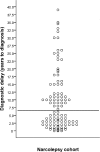Delayed diagnosis, range of severity, and multiple sleep comorbidities: a clinical and polysomnographic analysis of 100 patients of the innsbruck narcolepsy cohort
- PMID: 23946711
- PMCID: PMC3716672
- DOI: 10.5664/jcsm.2926
Delayed diagnosis, range of severity, and multiple sleep comorbidities: a clinical and polysomnographic analysis of 100 patients of the innsbruck narcolepsy cohort
Abstract
Study objectives: Narcolepsy is reported to affect 26-56/100,000 in the general population. We aimed to describe clinical and polysomnographic features of a large narcolepsy cohort in order to comprehensively characterize the narcoleptic spectrum.
Methods: We performed a chart- and polysomnographybased review of all narcolepsy patients of the Innsbruck narcolepsy cohort.
Results: A total of 100 consecutive narcolepsy patients (87 with cataplexy [NC], 13 without cataplexy [N]) were included in the analysis. All subjects had either excessive daytime sleepiness or cataplexy as their initial presenting clinical feature. Age at symptom onset was 20 (6-69) years. Diagnostic delay was 6.5 (0-39) years. The complete narcolepsy tetrad was present in 36/100 patients; 28/100 patients had three cardinal symptoms; 29/100 had two; and 7/100 had only excessive daytime sleepiness. Severity varied broadly with respect to excessive daytime sleepiness (median Epworth Sleepiness Scale score: 18, range 10-24), cataplexy (8-point Likert scale: median 4.5, range 1-8), hypnagogic hallucinations (median 4.5, range 1-7), and sleep paralysis (median 3, range 1-7). Sleep comorbidity was highly prevalent and ranged from sleeprelated movement disorders (n = 55/100), parasomnias (n = 34/100), and sleeprelated breathing disorders (n = 24/100), to insomnia (n = 28/100). REM sleep without atonia or a periodic limb movement in sleep index > 5/h were present in most patients (90/100 and 75/100). A high percentage of narcoleptic patients in the present study had high frequency leg movements (35%) and excessive fragmentary myoclonus (22%). Of the narcolepsy patients with clinical features of REM sleep behavior disorder (RBD), 76.5% had EMG evidence for RBD on the multiple sleep latency test (MSLT), based on a standard cutoff of a minimum of 18% of 3-sec miniepochs.
Conclusion: This study is one of the largest monocentric polysomnographic studies to date of patients with narcolepsy and confirms the frequent comorbidity of narcolepsy with many other sleep disorders. Our study is the first to evaluate the percentage of patients with high frequency leg movements and excessive fragmentary myoclonus in narcolepsy and is the first to demonstrate EMG evidence of RBD in the MSLT. These findings add to the growing body of literature suggesting that motor instability is a key feature of narcolepsy.
Keywords: Polysomnography; cohort; diagnosis; gender; hypersomnia; hypocretin; sleep paralysis.
Figures
References
-
- Hublin C, Partinen M, Kaprio J, Koskenvuo M, Guilleminault C. Epidemiology of narcolepsy. Sleep. 1994;17:S7–12. - PubMed
-
- Silber MH, Krahn LE, Olson EJ, Pankratz VS. The epidemiology of narcolepsy in Olmsted County, Minnesota: a population-based study. Sleep. 2002;25:197–202. - PubMed
-
- Mignot E, Lin L, Finn L, et al. Correlates of sleep-onset REM periods during the multiple sleep latency test in community adults. Brain. 2006;129:1609–23. - PubMed
-
- American Academy of Sleep Medicine. The international classification of sleep disorders: diagnostics and coding manual. 2nd. Westchester, IL: American Academy of Sleep Medicine; 2005.
MeSH terms
LinkOut - more resources
Full Text Sources
Other Literature Sources
Medical


